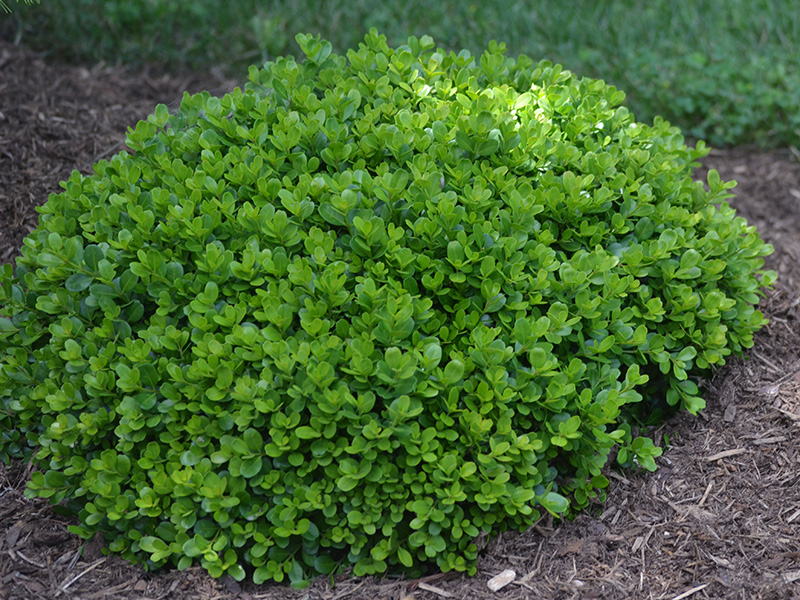
Woody > Buxus > Buxus microphylla > Buxus microphylla var. japonica 'Morris Midget'
Buxus microphylla
var. japonica 'Morris Midget'
Morris Midget Little Leaf Boxwood
Origin: Originated in the Morris Arboretum in Philadelphia as a sport from Buxus microphylla.
Mike's
Opinion


"
This is a very nice specimen for a rock garden or for container planting because it is a very slow grower it can be put in small areas. It best placed out of where it can be hit by harsh winter winds. This is also a great plant for bonsi trees.
Michael Pascoe, NDP., ODH., CLT., MSc. (Plant Conservation)
"
| Family |
| Buxaceae |
| Genus |
| Buxus |
| Species |
| microphylla |
| Cultivar |
| 'Morris Midget' |
| Category |
| Woody |
| Type |
| Shrub (evergreen) |
| Variety |
| japonica |
| Pronunciation |
| USDA Hardiness Zone |
| 5 - 9 |
| Canadian Hardiness Zone |
| 4a |
| RHS Hardiness Zone |
| H3 - H7 |
| Temperature (°C) |
| -29 - (-1) |
| Temperature (°F) |
| -20 - 30 |
| Height |
| 30 cm |
| Spread |
| 45 cm |
Photographs
Description and Growing Information
Flowering Period
| General Description |
| Very slow growing plant that will only grow 30-45 cm after about 20 years the foliage has a yellowish green colour and in winter that colour becomes more intense. ‘Morris Midget’ must be covered to protect from wind desiccation in winter. |
| Landscape |
| Rock garden, container plant and low hedge plantings. |
| Cultivation |
| Morris Midget prefers cool moist soil with mulch around base of plant. Best suited in full sun but must be protected from winter winds and temperature. |
| Shape |
| Low growing dense dwarf evergreen very compact with a natural globe shape. |
| Growth |
| Slow |
| ID Characteristic |
| Opposite leaves with small elliptical or rounded with notches in the apex, square green stems. The leaves a yellowish green colour and even more intense in winter. Dense low growing mounded plant that’s foliage has a very noticeable and distinct odour. |
| Pests |
| Buxus can suffer from boxwood leaf miner, nematodes and mites. Recently Boxwood blight has become a major problem both in Europe and most of North America. The fungus Cylindrocladium buxicola causes leaf spots, defoliation and even extensive die-back. The disease can be spread by water splash, tools and footwear and can survive for up to six years in the soil. It thrives in moist, humid environments but is killed when exposed to temperatures in excess of 33 °C for at least a week. The disease also affects Pachysandra, Sarocococca and Buxus balearica, sinica, macowanii, microphylla, bodinieri, glomerata, harlandii, sempervirens and riparia. |
| Habitat |
| Horticultural origin. |
| Bark/Stem Description |
| On young growth the stems will be green and square in shape as the plant ages the stems will become brown but are covered by the foliage. |
| Flower/Leaf Bud Description |
| Small ovoid with 1-2 pairs of specialized scales. 1-2 cm in size. |
| Leaf Description |
| Simple small obovate leaves with a leathery like feel. The leaves can get as big as 1.22 cm, Yellowish green leaves more intense in winter. The leaves must be protected from harsh winter winds. |
| Flower Description |
| Dioecious, rarely flowers, non-showy, yellowish in colour with a potent fragrance that will attract bees. 1-2 cm in size. |
| Fruit Description |
| Three celled capsule 1-3 cm insignificant with shiny black seeds. |
| Colour Description |
| Dark green to a yellow colour in summer in autumn and winter depending on temperature can go a yellowish brown. |
| Texture Description |
| Medium-fine texture leathery feel stems feel smooth with four sides. |
| Notable Specimens |
| The Gardens of Fanshawe College, (dwarf conifer garden), London, Ontario, Canada. |
| Propagation |
| Propagate in mid-summer by taking semi-ripe cuttings from the current season's growth. Collect in the early morning using a sharp knife to cut pieces 10 - 15 cm in length. Remove all leaves from the lower third and pinch out any soft terminal growth. Dip into a number 2 rooting hormone, insert into trays or pots of cutting compost (50/50 mix of compost and sharp sand or perlite) and water well. Place in a propagator with bottom heat set at 15°C with or without mist; rooting should occur in 4 - 6 weeks. |
References
Sheridan Nursery, Georgetown, Ontario. Connon Nursery Waterdown, Ontario. Rice Road Greenhouses and Garden Centre Welland, Ontario.

